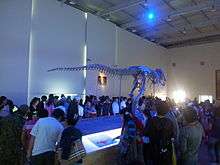United States v. One Tyrannosaurus Bataar Skeleton
United States v. One Tyrannosaurus Bataar Skeleton (1:13−cv−00857) is a 2013 United States District Court for the Southern District of New York judgment regarding a requested order from the United States government to seize an imported Mongolian Tarbosaurus (referred to as a Tyrannosaurus bataar in the case title) skeleton related to smuggling law and the applicability of Mongolian law in the United States.[1]
| United States v. One Tyrannosaurus Bataar Skeleton | |
|---|---|
 | |
| Court | United States District Court for the Southern District of New York |
| Full case name | United States v. One Tyrannosaurus Bataar Skeleton |
| Decided | May 6, 2013 |
| Citation(s) | 1:13−cv−00857 |
The form of the styling of this case — the defendant being an object, rather than a legal person — is because this is a jurisdiction in rem (power over objects) case, rather than the more familiar in personam (over persons) case.
History
_officials_return_a_Tarbosaurus_bataar_skeleton_to_the_government_of_Mongolia_during_a_repatriation_ceremony_May_6%2C_2013%2C_at_a_Manhattan_hotel_in_New_York_130506-H-ZZ999-002.jpg)
In 2012, Florida businessman Eric Prokopi imported a Tyrannosaurus bataar (or Tarbosaurus bataar) skeleton from Mongolia into the United Kingdom. From there he imported it into the United States declaring on the import customs form that the skeleton originated in Great Britain.[1] The skeleton was sold in New York for over $1 million. However, the Government of Mongolia declared an interest in the skeleton and obtained a restraining order preventing the sale being completed. This was because the Constitution of Mongolia declares that all dinosaur fossils are "culturally significant" and can not be removed from Mongolia without government consent.[2] The skeleton had been recognized by Mongolian paleontologist Bolortsetseg Minjin as coming from Mongolia.[3] Paleontologists examined the skeleton and confirmed it was of Mongolian origin and not British origin as the import papers had indicated.[4] The United States Attorney's Office filed a complaint with the court with regard to the false import documents and to seize the skeleton with the aim of repatriating it to Mongolia.[1]
Prokopi argued against this, claiming that the majority of the skeleton was already in the United States and did not comprise part of the shipment that had false import papers claiming it was from the UK instead of Mongolia. He also argued that Tyrannosaurus bataar could also be found in China and not solely in Mongolia so there was doubt as to if the skeleton did belong to Mongolia. He also argued that while the Constitution of Mongolia prohibited export of "culturally significant" artifacts, it did not apply under United States law.[4]
Judgment

In October 2012, Prokopi was arrested in relation to the Tyrannosaurus bataar skeleton as well as two other dinosaur skeletons on counts of conspiracy to smuggle illegal goods, possess stolen property, and make false statements, one count of smuggling goods into the United States, and one count of interstate sale and receipt of stolen goods. As part of his plea bargain, he agreed to give up all claims to the skeletons. As a result of the withdrawal of title to the skeleton, in 2013 the judge dismissed Prokopi's complaint and granted the United States the right to seize the skeleton in order to return it to Mongolia.[5] Prokopi was later jailed for three months.[6] In May 2013, the United States returned the skeleton to Mongolia,[7] where it was put on display at a pop-up museum in Sukhbaatar Square in the capital, Ulaanbaatar,[8] and then exhibited in Darkhan.[9]
Legacy
The case was later cited as precedent for the principle that the government may provide paleontological evidence if a country of origin is obscured.[10] The case also brought about a discussion in American media regarding the effect of "dinosaur smuggling".[9][11][12]
In 2015, American actor Nicolas Cage returned a Tyrannosaurus bataar skull he had purchased in 2007 (after outbidding Leonardo DiCaprio). The skull was purchased from a gallery which has previously sold fossils smuggled by Prokopi.[6][13]
In 2018, a book called The Dinosaur Artist: Obsession, Betrayal and the Quest for the Ultimate Trophy by writer Paige Williams was published by Hatchette Books.
References
- "Manhattan U.S. Attorney Announces Return To Mongolia Of Fossils Of Over 18 Dinosaur Skeletons". Department of Justice. 2014-07-10. Retrieved 2016-03-03.
- Joseph Serna (2013-01-14). "Saving this dinosaur took a skeleton crew". Los Angeles Times. Retrieved 2016-03-03.
- Boodhoo, Thea (15 February 2017). "Saving Mongolia's dinosaurs and inspiring the next generation of paleontologists" (March 2017). American Geosciences Institute. EARTH Magazine. Retrieved 19 February 2017.
- "MEMORANDUM AND ORDER: The time for claimant to reply on the motion to dismiss is stayed for United States of America v. One Tyrannosaurus Bataar Skeleton". justia.com. Retrieved 2016-03-03.
- "Stolen Dinosaur, Bought For $1 Million At New York Auction, Will Be Returned To Mongolia". Forbes (archived). 2013-05-06. Archived from the original on October 17, 2015. Retrieved 2016-03-03.
- "Nicolas Cage returns stolen dinosaur skull to Mongolia". BBC News. Retrieved 2016-03-03.
- "US fossils dealer jailed for dinosaur smuggling". BBC News. Retrieved 2016-03-03.
- Williams, Paige (2013-01-21). "Bones of Contention". The New Yorker. ISSN 0028-792X. Retrieved 2017-09-27.
- "The Black Market for Dinosaurs". The New Yorker. 2014-06-07. Retrieved 2016-03-03.
- "UNITED STATES OF AMERICA v. ALL ASSETS HELD IN ACCOUNT NUMBER 80020796, IN THE NAME OF DORAVILLE PROPERTIES CORPORATION, AT DEUTSCHE BANK INTERNATIONAL, LIMITED IN JERSEY, CHANNEL ISLANDS, AND ALL INTEREST, BENEFITS OR ASSETS TR et al, No. 1:2013cv01832 – Document 79 (D.D.C. 2015)". justia.com. Retrieved 2016-03-03.
- "How do you smuggle a dinosaur? And 7 other questions about the fossil black market". Vox. Retrieved 2016-03-03.
- "Smuggled Dinosaur Skeleton: How Did Eric Prokopi Get A T-Rex Fossil Out Of Mongolia?". International Science Times. 2013-05-07. Retrieved 2016-03-03.
- Reuters (2015-12-22). "Nicolas Cage returns stolen Mongolian dinosaur skull he bought at gallery". The Guardian. Retrieved 2016-03-28.